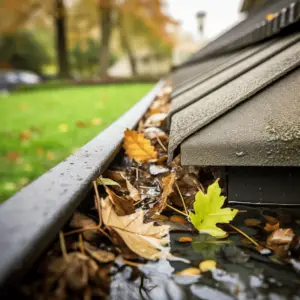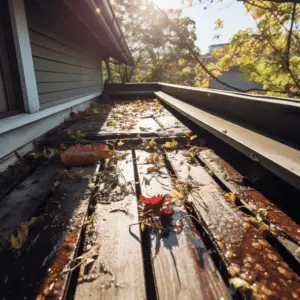Roof leaks, no matter how small, shouldn’t be neglected. Finding and fixing them quickly is essential to avoid more harm and expensive repairs. Ignoring these minor leaks can cause huge issues, like mold growth, structural damage, or even roof failure.
The key point of attending to minor roof leaks is prevention. By locating and mending them fast, homeowners can save themselves from future problems. This not only safeguards their investment in the property but also gives their family a safe and comfortable living environment.
One crucial part to think about with roof leaks is that they are not always visible. In fact, many small roof leaks can go undetected for long periods, causing severe destruction over time. This shows the importance of regular inspections as a preventive measure.
Take Tom’s story for example. One wet afternoon, he saw a patch of water forming on his bedroom ceiling. Thinking it was only a one-time thing, he ignored it. He didn’t know this seemingly insignificant leak would turn into massive water damage inside his home. The wait in repair cost Tom a lot of money and trouble, which could have been avoided if he had tackled the problem instantly.
Table of Contents
Common signs of roof leaks

Roof leaks can be a real nightmare for homeowners. Promptly identifying and repairing them is key to preventing further damage. Here are some common signs of a roof leak:
- Water stains on the ceiling: Discoloured patches, bulging areas, or peeling paint.
- Dripping sounds or water droplets: During heavy rain or snow melting.
- Musty odour: In certain parts of the house, especially near ceilings or walls.
- Mold growth: Dark spots, green patches, or fuzzy textures on walls/ceilings.
- Damaged shingles: Cracked, curled, or missing shingles.
- Clogged gutters: Overflowing water onto the roof, finding gaps or weak spots.
Also, check for unexplained spikes in water bills – this could be a hidden leak! If you notice any of these signs, act fast to avoid costly repairs and protect your home from the serious effects of roof leaks. Don’t hesitate to call a professional roofer for inspection and repairs.
Step 1: Safety precautions before inspecting the roof
Inspecting a roof? Keep yourself safe! Follow these steps:
- Wear a hard hat, safety glasses and non-slip shoes.
- Secure a ladder, on even ground. It must extend 3 feet above the roof edge.
- Check the weather before proceeding. No inspections in bad weather or high winds.
- Let someone know of your plans. Have them nearby in case of an emergency.
Remember: Roof safety is essential. Negligence can be dangerous!
Pro Tip: For extra safety, use fall protection equipment like a harness or a personal fall arrest system.
Step 2: Assessing the extent of the leak
Assess the extent of the leak with our 6-step guide! Carefully examine the affected area to determine severity and scope.
- Locate the source. Look in the attic or crawl space for water damage, wet insulation, mold, or discoloration on the ceiling. Follow any stains or drips.
- Check nearby walls, vents, chimneys, and skylights. Water may travel along rafters or other structures before dripping.
- Examine roofing materials for damage or missing shingles, cracked tiles, or other visible signs of wear. Pay attention to areas around vents and flashing.
- Assess interior damage. Look for water stains on ceilings, walls, and windows. Measure the size of the stains. Check for soft spots or sagging ceiling panels.
- Consider external factors. Was there recent heavy rain, strong winds, or hailstorms?
- Consult a pro if unsure or if significant damage found. Document findings with photos and notes. Remember timely action is key to prevent further damage to your roof and property. Act fast!
Step 3: Locating the source of the leak
When pinpointing the source of a roof leak, accuracy is key. To help you find and fix minor leaks, here are 4 steps:
| 1. Inspect inside: | Look for water damage, stains, peeling paint, or mold. These tell-tale signs can give you clues. |
| 2. Check the attic: | Look for water intrusion, like wet insulation, wet wood, or light coming through cracks/holes. Use a flashlight to search everywhere. |
| 3. Examine outside: | Check shingles for missing, cracked, or curling ones. Focus on vents, chimneys, and skylights. |
| 4. Do a water test: | If you’re still not sure, have a helper spray specific areas with a garden hose. Look for water entering from the bottom up. |
Besides these steps, keep in mind:
- Weather conditions: Leaks may happen only during certain weather conditions, like heavy rain or wind. Note if you see a pattern.
- Hire pros: If you’re not sure, don’t hesitate to get help. Experts have the know-how and tools to locate and repair the leak.
It’s vital to understand how to find the source of a roof leak. Neglecting minor leaks can cause major damage, and even put you in danger. So, it’s best to act fast to avoid costly consequences.
Step 4: Temporary measures to stop the leak
Essential temporary measures are key to halt further roof damage. Follow these 3 steps for quick help:
- Track down the leak’s source. Check your attic or crawl space for wet areas on the ceiling. Find its origin on the roof.
- Seal the affected area. Clean and dry the spot before applying sealant like roofing cement or silicone caulk. Make sure it’s evenly applied for a watertight barrier.
- Make a patch. If you can access the roof, cover the harm with tarp or plastic sheeting. Fix it with nails or weighted objects until permanent repairs.
Temporary measures give immediate relief, but don’t promise long-term success. One homeowner tried to seal the leak without professional help. The underlying damage worsened, causing more expensive repairs.
Consulting a roofing pro is vital to check the damage and do the right repairs, so minor leaks don’t become major problems.
Step 5: Repairing the roof leak
Addressing minor roof leaks is vital. Follow these five simple steps to repair the leak:
- Assess the damage. Find the exact location of the leak inside and out. Look for water stains or mold.
- Ready the area. Take away any debris, like branches or leaves, on the roof. Sweep away dirt, so the work area is clean.
- Apply roofing cement. Spread it evenly with a putty knife, covering the whole problem area.
- Reinforce with patching fabric. Put a piece of patching fabric over the wet roofing cement and press down firmly.
- Seal and finish. Allow the roofing cement to dry, then apply another layer. Smooth it with the putty knife for a perfect finish.
It’s best to consult a professional if the damage is big. To avoid future leaks, do regular roof inspections and maintenance. Repairing minor roof leaks quickly is essential, as neglecting them can lead to huge structural damage and costly repairs. Safeguard your home and stay proactive.
Step 6: Preventive measures to avoid future leaks

To avoid future roof leaks, preventive actions are a must! Here’s what to do:
- Inspect often: Check your roof frequently for any weak spots or areas that may leak. Look for broken, missing, or curled shingles, as well as faulty flashing or unsealed vents and chimneys.
- Don’t let debris accumulate: Remove any leaves, branches or other debris that gathers on the roof’s surface. Otherwise, moisture and moss/algae can build up, resulting in leaks.
- Ventilate: Make sure the attic is properly ventilated. Poor ventilation can cause condensation on the roof’s underside, causing water damage and leaks.
It’s essential to keep in mind that preventive measures should be customized to fit the condition of your roof. Consulting an expert roofer can provide helpful advice.
Fun Fact: The National Roofing Contractors Association (NRCA) states that regular maintenance and preventive steps can add 25% more life to a roof!
Conclusion: Importance of addressing minor roof leaks promptly
Minor roof leaks must be addressed promptly. Ignoring them can cause huge problems. Structural issues, mold, and poor air quality are just a few. A timely response is essential to ensure the integrity of your roof and protect your home.
Neglecting minor roof leaks carries risks far beyond water damage. Seeping water weakens the foundation, making the roof more vulnerable to collapse in extreme weather. Moisture also creates a perfect breeding ground for mold and mildew. This not only affects the look of your home, but also your health. Mold spores can trigger allergies and respiratory issues, especially in people with asthma.
Addressing minor roof leaks quickly preserves indoor air quality too. Stagnant water encourages bacteria growth, which pollutes the air you breathe inside your home. Prolonged exposure to damp environments, according to the EPA, may lead to respiratory conditions. So, don’t delay – act now to prevent further damage and costly repairs.
Frequently Asked Questions
1. How do I know if I have a minor roof leak?
Signs of a minor roof leak include water stains on your ceiling, musty odors, and bulging or cracking paint. You may also notice dripping water during heavy rainfall.
2. How can I locate the source of the roof leak?
The best way to identify a roof leak is to inspect your attic during the day. Look for any signs of water or sunlight entering through cracks, gaps, or missing shingles. You can also use a hose to simulate rainfall and track where the water enters.
3. Can I fix a minor roof leak on my own?
Yes, if you’re comfortable with basic DIY tasks, you can repair a minor roof leak. However, keep in mind that if the leak is extensive or if you’re unsure about the repair, it’s best to hire a professional roofer.
4. What materials do I need to fix a minor roof leak?
The materials needed may vary depending on the type of roof you have, but commonly used items include roofing cement, roofing nails, a putty knife, roofing tar, and replacement shingles.
5. How do I repair a minor roof leak?
To repair a minor roof leak, start by cleaning the affected area and removing any debris. Apply roofing cement to seal small cracks or gaps, replace damaged shingles, and use roofing tar to cover larger areas. Ensure a proper seal and consider using roofing nails for extra security.
6. When should I consider calling a professional for help?
You should call a professional roofer if you’re unsure about the extent of the damage, if the leak is widespread, or if you’re uncomfortable with DIY repairs. Additionally, if you’re unable to locate the source of the leak or if the repairs seem too complex, it’s best to seek professional assistance.